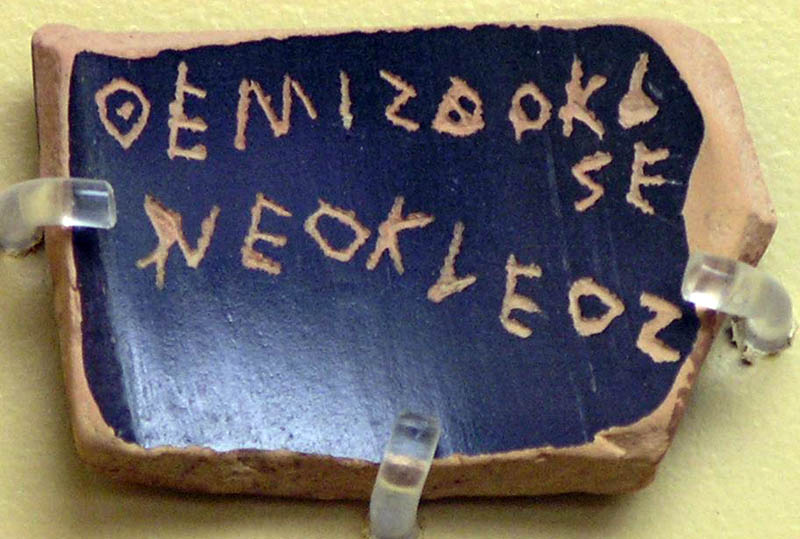|
Second Declension
The second declension is a category of nouns in Latin and Greek with similar case formation. In particular, these nouns are thematic, with an original ''o'' in most of their forms. In Classical Latin, the short ''o'' of the nominative and accusative singular became ''u''. Both Latin and Greek have two basic classes of second-declension nouns: masculine or feminine in one class, neuter in another. Most words of the former class have ''-us'' (Latin) or -ος ''-os'' (Greek) in the nominative singular, except for the r-stem nouns in Latin, and the "Attic" declension and contracted declension in Attic Greek (when these groups are considered part of this declension). The latter class, i.e. the neuter nominative/accusative singular, usually ends with ''-um'', in Latin and -ον (''-on''), in Greek, matching the accusative of the former. In Latin, the masculine words of the second declension that end with ''-us'' in the nominative case, are differently declined from the latter in the vo ... [...More Info...] [...Related Items...] OR: [Wikipedia] [Google] [Baidu] |
Latin
Latin (, or , ) is a classical language belonging to the Italic branch of the Indo-European languages. Latin was originally a dialect spoken in the lower Tiber area (then known as Latium) around present-day Rome, but through the power of the Roman Republic it became the dominant language in the Italian region and subsequently throughout the Roman Empire. Even after the fall of Western Rome, Latin remained the common language of international communication, science, scholarship and academia in Europe until well into the 18th century, when other regional vernaculars (including its own descendants, the Romance languages) supplanted it in common academic and political usage, and it eventually became a dead language in the modern linguistic definition. Latin is a highly inflected language, with three distinct genders (masculine, feminine, and neuter), six or seven noun cases (nominative, accusative, genitive, dative, ablative, and vocative), five declensions, four verb conjuga ... [...More Info...] [...Related Items...] OR: [Wikipedia] [Google] [Baidu] |
Ancient Greek
Ancient Greek includes the forms of the Greek language used in ancient Greece and the ancient world from around 1500 BC to 300 BC. It is often roughly divided into the following periods: Mycenaean Greek (), Dark Ages (), the Archaic period (), and the Classical period (). Ancient Greek was the language of Homer and of fifth-century Athenian historians, playwrights, and philosophers. It has contributed many words to English vocabulary and has been a standard subject of study in educational institutions of the Western world since the Renaissance. This article primarily contains information about the Epic and Classical periods of the language. From the Hellenistic period (), Ancient Greek was followed by Koine Greek, which is regarded as a separate historical stage, although its earliest form closely resembles Attic Greek and its latest form approaches Medieval Greek. There were several regional dialects of Ancient Greek, of which Attic Greek developed into Koine. Dia ... [...More Info...] [...Related Items...] OR: [Wikipedia] [Google] [Baidu] |
Grammatical Case
A grammatical case is a category of nouns and noun modifiers (determiners, adjectives, participles, and Numeral (linguistics), numerals), which corresponds to one or more potential grammatical functions for a nominal group in a wording. In various languages, nominal groups consisting of a noun and its modifiers belong to one of a few such categories. For instance, in English language, English, one says ''I see them'' and ''they see me'': the nominative case, nominative pronouns ''I/they'' represent the perceiver and the accusative case, accusative pronouns ''me/them'' represent the phenomenon perceived. Here, nominative case, nominative and accusative case, accusative are cases, that is, categories of pronouns corresponding to the functions they have in representation. English language, English has largely lost its inflected case system but personal pronouns still have three cases, which are simplified forms of the Nominative case, nominative, Accusative case, accusative and gen ... [...More Info...] [...Related Items...] OR: [Wikipedia] [Google] [Baidu] |
Inflection
In linguistic morphology, inflection (or inflexion) is a process of word formation in which a word is modified to express different grammatical categories such as tense, case, voice, aspect, person, number, gender, mood, animacy, and definiteness. The inflection of verbs is called ''conjugation'', and one can refer to the inflection of nouns, adjectives, adverbs, pronouns, determiners, participles, prepositions and postpositions, numerals, articles, etc., as ''declension''. An inflection expresses grammatical categories with affixation (such as prefix, suffix, infix, circumfix, and transfix), apophony (as Indo-European ablaut), or other modifications. For example, the Latin verb ', meaning "I will lead", includes the suffix ', expressing person (first), number (singular), and tense-mood (future indicative or present subjunctive). The use of this suffix is an inflection. In contrast, in the English clause "I will lead", the word ''lead'' is not inflected for any of pe ... [...More Info...] [...Related Items...] OR: [Wikipedia] [Google] [Baidu] |
Thematic Stem
In Indo-European studies, a thematic vowel or theme vowel is the vowel or from ablaut placed before the ending of a Proto-Indo-European (PIE) word. Nouns, adjectives, and verbs in the Indo-European languages with this vowel are thematic, and those without it are athematic. Used more generally, a thematic vowel is any vowel found at the end of the stem of a word. Outside Indo-European, the term "thematic vowel" is also used in the grammar of Kartvelian languages (see Georgian verb paradigm for more information on thematic vowels). Proto-Indo-European PIE verbs and nominals (nouns and adjectives) consist of three parts: :\underbrace_ The thematic vowel, if present, occurs at the end of the suffix (which may include other vowels or consonants) and before the ending: * 'heat' > Ancient Greek (''thérmos'') * '(he) bears' > Sanskrit ''bhárati'', Gothic Athematic forms, by contrast, have a suffix ending in a consonant, or no suffix at all (or arguably a null suffix): * 'fathe ... [...More Info...] [...Related Items...] OR: [Wikipedia] [Google] [Baidu] |
Classical Latin
Classical Latin is the form of Literary Latin recognized as a literary standard by writers of the late Roman Republic and early Roman Empire. It was used from 75 BC to the 3rd century AD, when it developed into Late Latin. In some later periods, it was regarded as good or proper Latin, with following versions viewed as debased, degenerate, or corrupted. The word ''Latin'' is now understood by default to mean "Classical Latin"; for example, modern Latin textbooks almost exclusively teach Classical Latin. Cicero and his contemporaries of the late republic referred to the Latin language, in contrast to other languages such as Greek, as or . They distinguished the common vernacular, however, as Vulgar Latin (''sermo vulgaris'' and ''sermo vulgi''), in contrast to the higher register that they called , sometimes translated as "Latinity". ''Latinitas'' was also called ("speech of the good families"), ''sermo urbanus'' ("speech of the city"), and in rare cases ''sermo nobilis'' ("nob ... [...More Info...] [...Related Items...] OR: [Wikipedia] [Google] [Baidu] |
Nominative
In grammar, the nominative case (abbreviated ), subjective case, straight case or upright case is one of the grammatical cases of a noun or other part of speech, which generally marks the subject of a verb or (in Latin and formal variants of English) the predicate noun or predicate adjective, as opposed to its object or other verb arguments. Generally, the noun "that is doing something" is in the nominative, and the nominative is often the form listed in dictionaries. Etymology The English word ''nominative'' comes from Latin ''cāsus nominātīvus'' "case for naming", which was translated from Ancient Greek ὀνομαστικὴ πτῶσις, ''onomastikḗ ptôsis'' "inflection for naming", from ''onomázō'' "call by name", from ''ónoma'' "name". Dionysius Thrax in his The Art of Grammar refers to it as ''orthḗ'' or ''eutheîa'' "straight", in contrast to the oblique or "bent" cases. Characteristics The reference form (more technically, the ''least marked'') of ce ... [...More Info...] [...Related Items...] OR: [Wikipedia] [Google] [Baidu] |
Ancient Greek Nouns
In Ancient Greek, all nouns are classified according to grammatical gender (masculine, feminine, neuter) and are used in a number (singular, dual, or plural). According to their function in a sentence, their form changes to one of the five cases (nominative, vocative, accusative, genitive, or dative). The set of forms that a noun will take for each case and number is determined by the declension that it follows. Cases The five cases of Ancient Greek each have different functions. Nominative The Ancient Greek nominative, like the Proto-Indo-European nominative, is used for the subject and for things describing the subject ( predicate nouns or adjectives): * : : "For Socrates was wise and just." Vocative The vocative is used for addressing people or things. It is frequently the same as the nominative in the singular and always the same in the plural. * : : "What you say is true, Socrates." Accusative The accusative is used for the object of a verb, and also after preposit ... [...More Info...] [...Related Items...] OR: [Wikipedia] [Google] [Baidu] |
Attic Greek
Attic Greek is the Greek language, Greek dialect of the regions of ancient Greece, ancient region of Attica, including the ''polis'' of classical Athens, Athens. Often called classical Greek, it was the prestige (sociolinguistics), prestige dialect of the Hellenistic period, Greek world for centuries and remains the standard form of the language that is taught to students of ancient Greek. As the basis of the Hellenistic Koine Greek, Koine, it is the most similar of the ancient Greek dialects, ancient dialects to later Greek. Attic is traditionally classified as a member or sister dialect of the Ionic Greek, Ionic branch. Origin and range Greek language, Greek is the primary member of the Hellenic languages, Hellenic branch of the Indo-European languages, Indo-European language family. In ancient times, Greek had already come to exist in several dialects, one of which was Attic. The earliest Attested language, attestations of Greek, dating from the 16th to 11th centuries BC, are ... [...More Info...] [...Related Items...] OR: [Wikipedia] [Google] [Baidu] |
Vocative
In grammar, the vocative Grammatical case, case (list of glossing abbreviations, abbreviated ) is a grammatical case which is used for a noun that identifies a person (animal, object, etc.) being addressed, or occasionally for the noun modifiers (determiners, adjectives, participles, and numeral (linguistics), numerals) of that noun; the comma that should be applied in such a context is referred to as a vocative comma. The usage of vocative case in the English language (and many others where commas are used) necessitates a comma to help clarify the writer's intent; failure to strictly adhere to this rule can lead to confusion over the writer's intent. A vocative expression is an expression of direct address by which the identity of the party spoken to is set forth expressly within a sentence. For example, in the sentence "I don't know, John," ''John'' is a vocative expression that indicates the party being addressed, as opposed to the sentence "I don't know John" in which "John" i ... [...More Info...] [...Related Items...] OR: [Wikipedia] [Google] [Baidu] |
Latin Declension
Latin declension is the set of patterns according to which Latin words are declined—that is, have their endings altered to show grammatical case, number and gender. Nouns, pronouns, and adjectives are declined (verbs are conjugated), and a given pattern is called a declension. There are five declensions, which are numbered and grouped by ending and grammatical gender. Each noun follows one of the five declensions, but some irregular nouns have exceptions. Adjectives are of two kinds: those like 'good' use first-declension endings for the feminine, and second-declension for masculine and neuter. Other adjectives such as belong to the third declension. There are no fourth- or fifth-declension adjectives. Pronouns are also of two kinds, the personal pronouns such as 'I' and 'you ()', which have their own irregular declension, and the third-person pronouns such as 'this' and 'that' which can generally be used either as pronouns or adjectivally. These latter decline in a sim ... [...More Info...] [...Related Items...] OR: [Wikipedia] [Google] [Baidu] |





